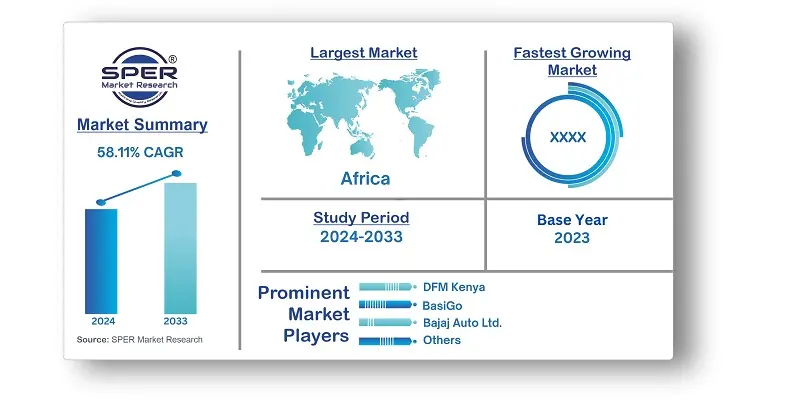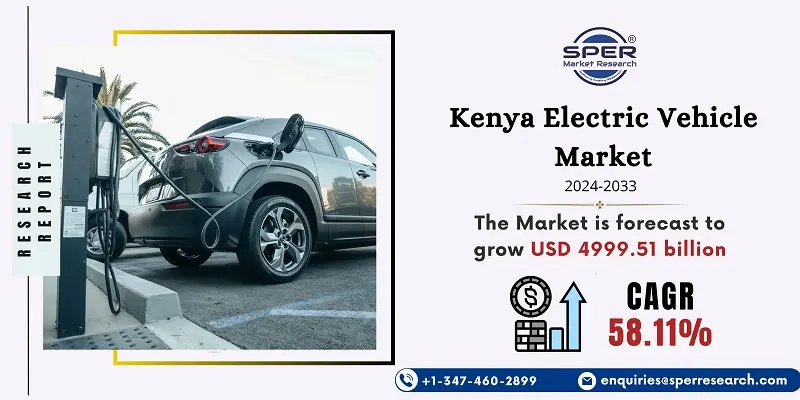
Kenya Electric Vehicle Market Growth, Size, Trends, Share, Demand, Revenue and Future Outlook
Kenya Electric Vehicle Market Size- By Vehicle Type, By Component, By Vehicle Class, By Propulsion, By Vehicle Drive Type, By Vehicle Top Speed, By Charging Point Type, By Vehicle Connectivity- Regional Outlook, Competitive Strategies and Segment Forecast to 2033
| Published: Jul-2024 | Report ID: AMIN24176 | Pages: 1 - 105 | Formats*: |
| Category : Automotive & Transportation | |||
- May 2024; A nearby startup revealed a reasonable electric bike customized for metropolitan suburbanites, tending to the popularity for bikes. These advancements feature Kenya's obligation to propelling its EV market and diminishing fossil fuel byproducts.
- March 2024; The nation's previously committed EV charging hall was launched, improving foundation and openness.


| Report Metric | Details |
| Market size available for years | 2020-2033 |
| Base year considered | 2023 |
| Forecast period | 2024-2033 |
| Segments covered | By Vehicle Type, By Components, By Vehicle Class, By Top Speed, By Vehicle Drive Type, By EV Charging Point Type, By Vehicle Connectivity, By Propulsion. |
| Regions covered | Central Region, Coastal Region, Rift Valley, Eastern Region, Western Region, Northern Region. |
| Companies Covered | Bajaj Auto Ltd., BasiGo, DFM Kenya, EVChaja, Electric Mobility Kenya, KenGen, Opibus, Tesla Inc., others. |
- Environmentally conscious consumers
- Urban commuters
- Corporate fleets
- Public transportation operators
- Government agencies
- Ride-sharing and taxi services
- Logistics and delivery companies
- Renewable energy advocates
- Real estate developers investing in green buildings
- Technological innovators and early adopters
| By Vehicle Type: |
|
| By Component: |
|
| By Vehicle Class: |
|
| By Top Speed: |
|
| By Vehicle Drive Type: |
|
| By EV Charging Point Type: |
|
| By Vehicle Connectivity: |
|
| By Propulsion: |
|
- Kenya Electric Vehicle Market Size (FY’2024-FY’2033)
- Overview of Kenya Electric Vehicle Market
- Segmentation of Kenya Electric Vehicle Market by Vehicle Type (Two-Wheeler, Passenger Vehicle, Bus, Trucks)
- Segmentation of Kenya Electric Vehicle Market by Component (Battery Cells & Packs, On-Board Charge Motor, Reducer, Fuel Stack, Power Control Unit, Battery Management System, Fuel Processor, Power Conditioner, Air Compressor, Humidifier)
- Segmentation of Kenya Electric Vehicle Market by Vehicle Class (Low- Priced, Mid-Priced, Luxury)
- Segmentation of Kenya Electric Vehicle Market by Top Speed (<125 MPH, >125 MPH)
- Segmentation of Kenya Electric Vehicle Market by Vehicle Drive Type (Front Wheel Drive, Rear Wheel Drive, All Wheel Drive)
- Segmentation of Kenya Electric Vehicle Market by EV Charging Point Type (Normal Charging, Super Charging)
- Segmentation of Kenya Electric Vehicle Market by Vehicle Connectivity (V2B or V2H, V2G, V2V, V2X)
- Segmentation of Kenya Electric Vehicle Market by Propulsion (BEV, PHEV, FCEV.)
- Statistical Snap of Kenya Electric Vehicle Market
- Expansion Analysis of Kenya Electric Vehicle Market
- Problems and Obstacles in Kenya Electric Vehicle Market
- Competitive Landscape in the Kenya Electric Vehicle Market
- Impact of COVID-19 and Demonetization on Kenya Electric Vehicle Market
- Details on Current Investment in Kenya Electric Vehicle Market
- Competitive Analysis of Kenya Electric Vehicle Market
- Prominent Players in the Kenya Electric Vehicle Market
- SWOT Analysis of Kenya Electric Vehicle Market
- Kenya Electric Vehicle Market Future Outlook and Projections (FY’2024-FY’2033)
- Recommendations from Analyst
1.1. Scope of the report1.2. Market segment analysis
2.1. Research data source
2.1.1. Secondary Data2.1.2. Primary Data2.1.3. SPER’s internal database2.1.4. Premium insight from KOL’s
2.2. Market size estimation
2.2.1. Top-down and Bottom-up approach
2.3. Data triangulation
4.1. Driver, Restraint, Opportunity and Challenges analysis
4.1.1. Drivers4.1.2. Restraints4.1.3. Opportunities4.1.4. Challenges
4.2. COVID-19 Impacts of the Kenya Electric Vehicle Market.
5.1. SWOT Analysis
5.1.1. Strengths5.1.2. Weaknesses5.1.3. Opportunities5.1.4. Threats
5.2. PESTEL Analysis
5.2.1. Political Landscape5.2.2. Economic Landscape5.2.3. Social Landscape5.2.4. Technological Landscape5.2.5. Environmental Landscape5.2.6. Legal Landscape
5.3. PORTER’s Five Forces
5.3.1. Bargaining power of suppliers5.3.2. Bargaining power of buyers5.3.3. Threat of Substitute5.3.4. Threat of new entrant5.3.5. Competitive rivalry
5.4. Heat Map Analysis
6.1. Kenya Electric Vehicle Market Manufacturing Base Distribution, Sales Area, Product Type6.2. Mergers & Acquisitions, Partnerships, Product Launch, and Collaboration in Agriculture Soil Sampling and Testing Market
7.1. Kenya Electric Vehicle Market Size, Share and Forecast, By Vehicle Type, 2020-20267.2. Kenya Electric Vehicle Market Size, Share and Forecast, By Vehicle Type, 2027-20337.3. Two-Wheeler7.4. Passenger Vehicle7.5. Bus7.6. Trucks
8.1. Kenya Electric Vehicle Market Size, Share and Forecast, By Component, 2020-20268.2. Kenya Electric Vehicle Market Size, Share and Forecast, By Component, 2027-20338.3. Battery Cells & Packs8.4. On-Board Charge8.5. Motor8.6. Reducer8.7. Fuel Stack8.8. Power Control Unit8.9. Battery Management System8.10. Fuel Processor8.11. Power Conditioner8.12. Air Compressor8.13. Humidifier
9.1. Kenya Electric Vehicle Market Size, Share and Forecast, By Vehicle Class, 2020-20269.2. Kenya Electric Vehicle Market Size, Share and Forecast, By Vehicle Class, 2027-20339.3. Low- Priced9.4. Mid-Priced9.5. Luxury
10.1. Kenya Electric Vehicle Market Size, Share and Forecast, By Top Speed, 2020-202610.2. Kenya Electric Vehicle Market Size, Share and Forecast, By Top Speed, 2027-203310.3. <125 MPH10.4. >125 MPH
11.1. Kenya Electric Vehicle Market Size, Share and Forecast, By Vehicle Drive Type, 2020-202611.2. Kenya Electric Vehicle Market Size, Share and Forecast, By Vehicle Drive Type, 2027-203311.3. Front Wheel Drive11.4. Rear Wheel Drive11.5. All Wheel Drive
12.1. Kenya Electric Vehicle Market Size, Share and Forecast, By EV Charging Point Type, 2020-202612.2. Kenya Electric Vehicle Market Size, Share and Forecast, By EV Charging Point Type, 2027-203312.3. Normal Charging12.4. Super Charging
13.1. Kenya Electric Vehicle Market Size, Share and Forecast, By Vehicle Connectivity, 2020-202613.2. Kenya Electric Vehicle Market Size, Share and Forecast, By Vehicle Connectivity, 2027-203313.3. V2B or V2H13.4. V2G13.5. V2V13.6. V2X
14.1. Kenya Electric Vehicle Market Size, Share and Forecast, By Propulsion, 2020-202614.2. Kenya Electric Vehicle Market Size, Share and Forecast, By Propulsion, 2027-203314.3. BEV14.4. PHEV14.5. FCEV
15.1. Kenya Electric Vehicle Market Size and Market Share
16.1. Kenya Electric Vehicle Market Size and Market Share By Region (2020-2026)16.2. Kenya Electric Vehicle Market Size and Market Share By Region (2027-2033)16.3. Central Region16.4. Coastal Region16.5. Rift Valley16.6. Eastern Region16.7. Western Region16.8. Northern Region
17.1. BAJAJ AUTO LTD.
17.1.1. Company details17.1.2. Financial outlook17.1.3. Product summary17.1.4. Recent developments
17.2. BASIGO
17.2.1. Company details17.2.2. Financial outlook17.2.3. Product summary17.2.4. Recent developments
17.3. DFM KENYA
17.3.1. Company details17.3.2. Financial outlook17.3.3. Product summary17.3.4. Recent developments
17.4. EVCHAJA
17.4.1. Company details17.4.2. Financial outlook17.4.3. Product summary17.4.4. Recent developments
17.5. ELECTRIC MOBILITY KENYA
17.5.1. Company details17.5.2. Financial outlook17.5.3. Product summary17.5.4. Recent developments
17.6. KENGEN
17.6.1. Company details17.6.2. Financial outlook17.6.3. Product summary17.6.4. Recent developments
17.7. OPIBUS
17.7.1. Company details17.7.2. Financial outlook17.7.3. Product summary17.7.4. Recent developments
17.8. TESLA INC.
17.8.1. Company details17.8.2. Financial outlook17.8.3. Product summary17.8.4. Recent developments
17.9. Others
SPER Market Research’s methodology uses great emphasis on primary research to ensure that the market intelligence insights are up to date, reliable and accurate. Primary interviews are done with players involved in each phase of a supply chain to analyze the market forecasting. The secondary research method is used to help you fully understand how the future markets and the spending patterns look likes.
The report is based on in-depth qualitative and quantitative analysis of the Product Market. The quantitative analysis involves the application of various projection and sampling techniques. The qualitative analysis involves primary interviews, surveys, and vendor briefings. The data gathered as a result of these processes are validated through experts opinion. Our research methodology entails an ideal mixture of primary and secondary initiatives.



Frequently Asked Questions About This Report
PLACE AN ORDER
Year End Discount
Sample Report
Pre-Purchase Inquiry
NEED CUSTOMIZATION?
Request CustomizationCALL OR EMAIL US
100% Secure Payment






Related Reports
Our Global Clients
Our data-driven insights have influenced the strategy of 200+ reputed companies across the globe.




















